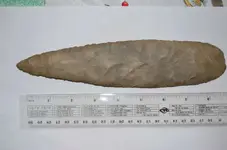Yes, these caches of knives very well could have been stored for future use, in fact some small cache pits have been found with multiple useable tools (points, bone, adzes, gouges, etc.) These 8"-12" long pieces are very thin, and almost use that involves torque or twist would probably snap them. I think some people have replicated them, wrapped the base in some type of leather to make a handle, and used them to process meat for drying and filleting fish even when thin.
these people were caribou hunters
As far as what they ate, that's an interesting part of the story up there. There were a couple of different traditions happening in along the northern Atlantic during the Archaic and later periods.
Some groups were hunting inland and were essentially following a "paleo" lifestyle by hunting caribou, as well as muskox and probably moose at the northern & southern ends of their range. They were probably fairly nomadic, small groups, etc. Archaeologists typically find kill sites, and occasionally small camps and hearths (as would be expected with groups of people who were on the move.)
There was also a coastal tradition that looked a lot more like what we think of for the Pacific Northwest/Alaska, lots of fish, birds, seals, walrus, etc. I'm not sure about Nova Scotia, but in Maine (right across the bay from NS) they've found lots trash pits with swordfish remains. Not one or two isolated chunks of bone or bill, but enough remains that archaeologists think these guys were going out miles off shore and harpooning basking swordfish and processing the meat to last them during the off season. (Most broad-bill swordfish was harpooned until fairly recently, a decent crew could get 50 a day.) They also took porpoise and dolphins that way. Most major river system also had yearly salmon runs before they were depleted in the 19th century. Beyond that, these were people who set up camps at convenient spots, and subsequent generations lived and died at the sites for hundreds of years. We have trash heaps/middens, burials, lots of hearths, and even trash pits with human waste in northern areas where it was preserved. They moved big distances on water, but often came back to the same couple of camps and probably left older people, kids at those camps seasonally.


